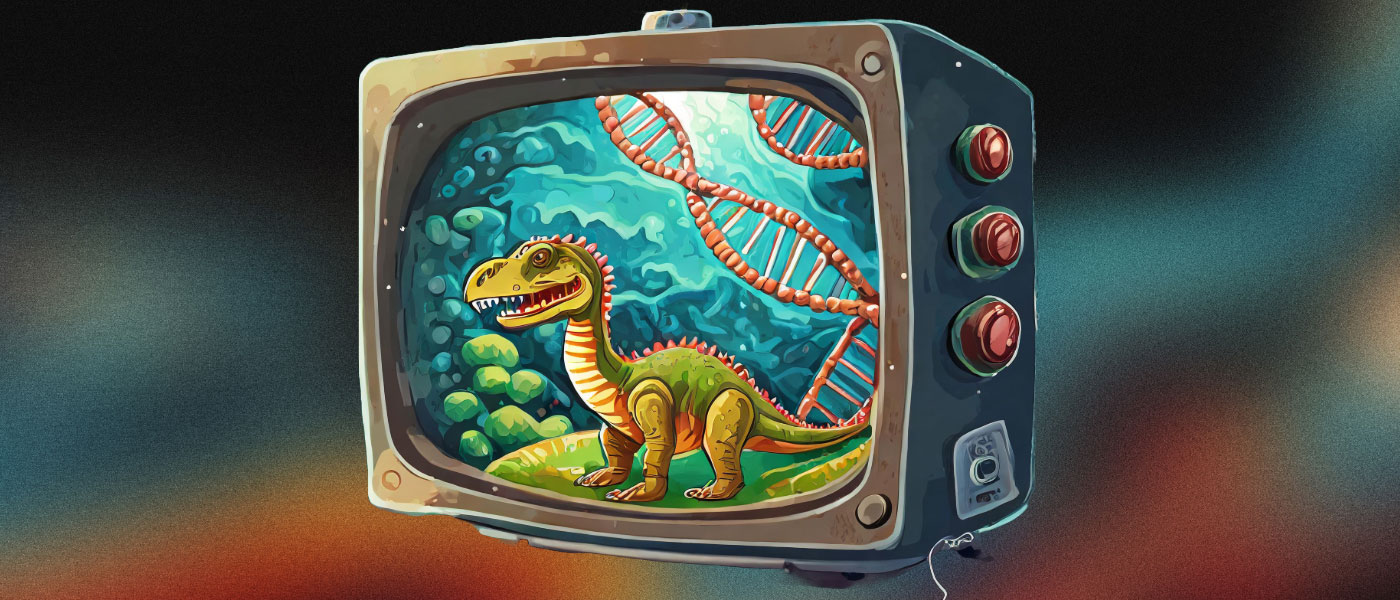From movies set in dystopian futures to real-life courtroom dramas, DNA, or deoxyribonucleic acid, has fueled storytellers’ imaginations for decades. The molecule responsible for shaping our understanding of biological inheritance has inspired everything from comic book tales about the birth of mutants to blockbuster films about resurrecting dinosaurs in a theme park, each captivating audiences worldwide.

Today (April 25) is National DNA Day, a day commemorating the completion of the Human Genome Project in 2003 and the discovery of DNA’s double helix in 1953. To find out more about this remarkable molecule’s impact on pop culture and society, The Daily sat down with Divita Mathur, assistant professor in the Department of Chemistry at Case Western Reserve University.
Read on to learn more from Mathur about how DNA intertwines with our daily lives.
1. The many universes of superheroes and villains find common ‘logic’ in DNA.
Namor, the original Aquaman from the Marvel universe, was first conceived in the comic world before World War II and can be considered the first mutant being to be created in American pop culture. Mutants are born from what DNA naturally does—genetic recombination and mutations. Now we have some very popular universes of mutants, including the Spider-Verse, Teenage Mutant Ninja Turtles, and X-Men.
2. DNA spans old and new worlds—from dinosaurs to the Na’vi.
When a very animated cartoon DNA in the 1993 movie Jurassic Park explained that a 66-million-year-old mosquito fossilized in a drop of amber was about to be squeezed to harvest dinosaur blood/DNA (spoiler alert!), audiences across the globe immediately came on board with having dinosaurs walk amongst men again. Even an asteroid that wiped the giant beasts off the planet could not fry nature’s hard-drive for storing genetic information: DNA. The movie went on to skip a few steps and took liberal creative license with others, but we learned that DNA is pretty resilient. Fifteen years later and after improved CGI effects, Avatar’s Na’vi in 2009 were infiltrated by humans who stole Na’vi DNA to become one of them—and gave us another record-smashing movie franchise.
3. Movies with dystopian worlds often feature DNA.
The movie that gave DNA most street cred is Gattaca (1997). What a clever name that uses DNA’s four-letter alphabet—A, T, C, G! Gattaca is the leader of the dystopian movie genre that espouses control over humankind using the most unique “fingerprint” we possess—our DNA code. Subsequently, DNA databases—or “Denabases”—are adopted by other movies such as Blade Runner 2049 to register every citizen using their DNA, kind of like your driver’s license, fingerprint, social security number, and retina scan all rolled into one. Dystopian worlds with DNA-reading machines as IDs are pretty ironclad in their control over the masses, until artificial intelligence-driven “organic” robot humanoids go rogue.
4. Pop culture continues to keep alive cases where DNA evidence was disruptive.
Evidently, 40+ drops of blood sampled from the murder scene of Nicole Brown Simpson and Ron Goldman were screened and presented as DNA evidence in the all-consuming trial: The People v. O.J. Simpson. Believing that DNA evidence gets the final word, both sides of the aisle somehow leveraged the evidence in their favor, leading to the famous acquittal and a larger debate over the role of such forensic evidence in highly televised trials. Before the turn of the century, DNA evidence revealed President Bill Clinton’s perjury and the media and public’s gross prejudice against Monica Lewinsky, adding fuel to an already eyeball-grabbing scandal involving a U.S. president.
5. DNA evidence enjoys an oddly elevated stature in solving crimes since the 90s.
“Benign” (or so we thought) versions of Denabases exist now, thanks to the democratization of DNA sequencing to find out one’s ancestry by simply mailing one’s spit to a company. Trace amounts of a killer’s DNA from a crime scene can end up matching a growing family tree on a genealogy database and can be used to track them down. It has spawned a new genre of crime-solving documentaries that have brought serial killers to justice because their distant cousins innocuously and voluntarily submitted their spit/DNA to an ancestry database. The Golden State Killer is one such popular “victim” of the genetic genealogy fad and the protagonist of a gripping documentary.
Looking to dive into genetics in pop culture—specifically in literature? Marie Vibbert has you covered. Vibbert is the webmaster for the College of Arts and Sciences at Case Western Reserve—and also a science fiction author, having written more than 90 short stories and three novels.
Vibbert recommends the following books with genetics in their plots:
- Lilith’s Brood by Octavia Butler: You can get it published as one volume now, but it is a trilogy—Dawn (1987), Adulthood Rites (1988), and Imago (1989). Aliens use genetic engineering to save humanity.
- Oryx and Crake (2003) by Margaret Atwood: In a future with genetic engineering ubiquitous enough to have “chicken nuggies” that grow like plants (don’t look under the stems!) one man tries to save humanity by changing it.
- Borne (2017) by Jeff VanderMeer: A post-genetic-apocalypse where everyone either works in genetics or desperately tries to survive in the vastly changed environment.
- Semiosis (2018) by Sue Burke: Explorers land on a planet with fascinating and unique creatures, including an intelligent species of plant that “gardens” the humans. Ultimately a hopeful story of interspecies cooperation.
- Blue Eyes by Vibbert herself: A short story dealing with near-future genetic engineering and its social consequences.


